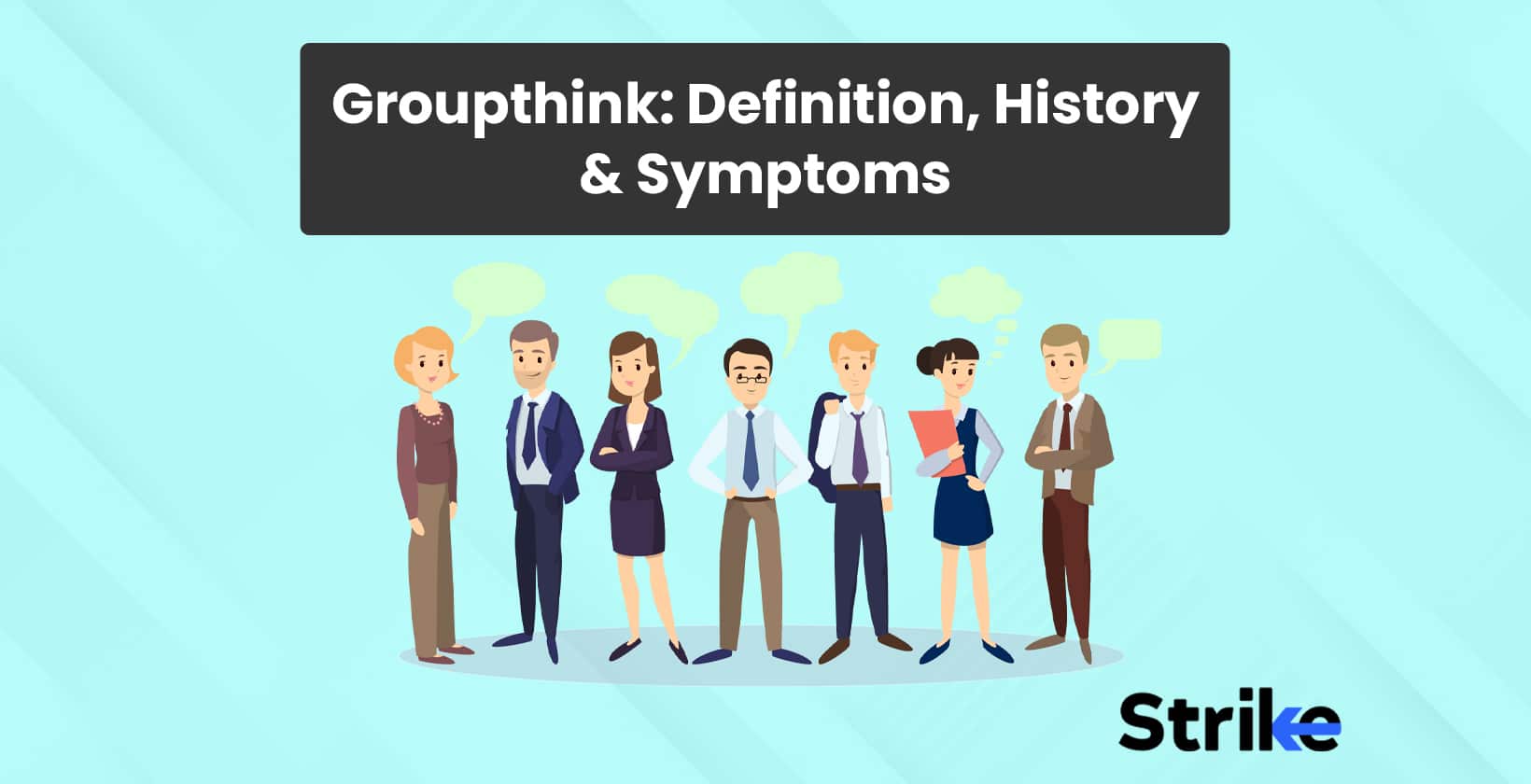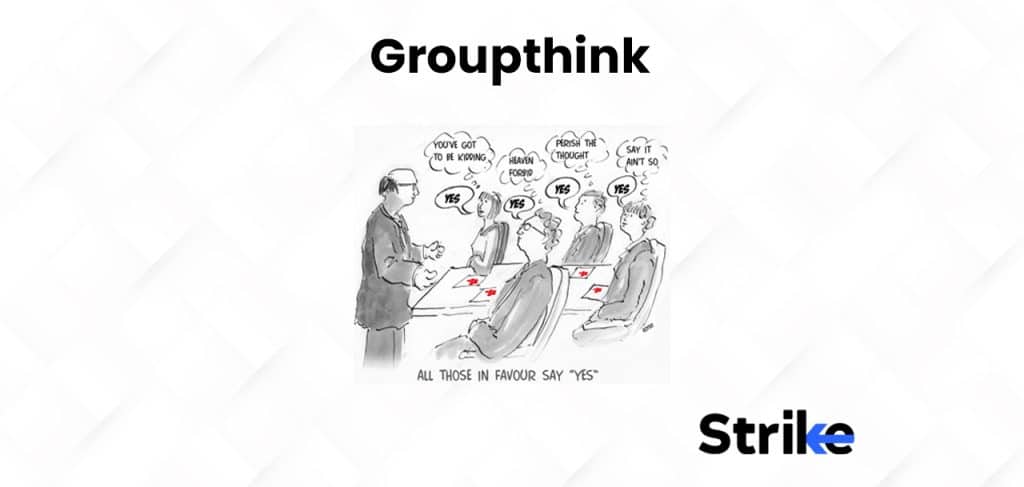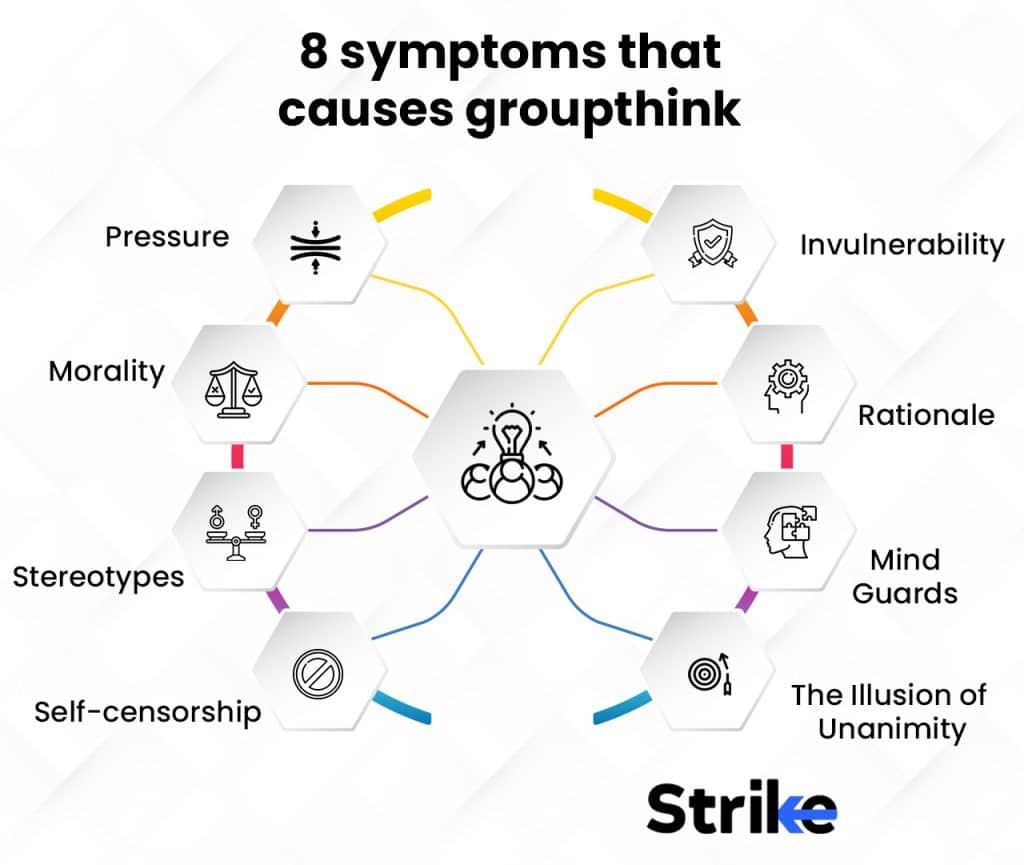
Groupthink is a phenomenon where a group of people come to a consensus without engaging in critical reasoning, often due to a desire not to upset the balance of the group. Groupthink phenomenon have significant consequences in fields including the stock market, where groupthink leads to irrational decision-making and the overlooking of important information.
The term “groupthink” was coined by social psychologist William H. Whyte Jr in 1952. “Groupthink” was used to describe a psychological phenomenon in which people in a group make irrational or problematic decisions because they want to maintain harmony and consensus within the group.
Groupthink leads to poor decision-making, as individuals suppress their own opinions and ideas in favor of the group’s consensus. This is particularly problematic in situations where group decision-making has significant consequences, such as in politics, business, or the military.
Groupthink has a significant impact on the stock market. A group of investors or traders starting to agree on a particular investment strategy creates a self-reinforcing cycle of buying or selling, which leads to a market bubble or a crash.
What is the meaning of Groupthink?
Groupthink refers to a psychological phenomenon that occurs when a group of people makes irrational or dysfunctional decisions. It is characterized by a strong desire for conformity and consensus within the group, which lead to the suppression of dissenting opinions and critical thinking. This leads to poor decision-making, as the group may overlook important information or alternatives that could lead to better outcomes.

Groupthink is also described as a type of conformity where individuals prioritize the group’s cohesion over their independent thinking. This happens when the group is highly cohesive, has a strong leader, and is under stress to make a decision quickly. Groupthink is also referred to as “mind guarding.”
Groupthink in psychology is defined as a mode of thinking that people engage in when they are deeply involved in a cohesive in-group, where the members’ strivings for unanimity override their motivation to realistically appraise alternative courses of action.
Groupthink affects an individual’s thinking by causing them to suppress their own opinions, doubts, and beliefs in favor of the group’s consensus. This leads to self-censorship, a lack of critical thinking, and a failure to consider all available options. Individuals may conform to the group’s decision even if they don’t agree with it, to avoid conflict or ostracism.
Groupthink becomes dangerous when it leads to poor decision-making, especially in high-stakes situations. This happens in various settings, such as politics, business, and the military. For example, the Bay of Pigs invasion in 1961 was a disastrous failure that was partly attributed to Groupthink among the decision-makers in the Kennedy administration.
Another example is the Challenger space shuttle disaster in 1986, where Groupthink among NASA engineers led to a faulty decision to launch the shuttle in cold weather conditions.
What is the Origin of Groupthink?
William H. Whyte first introduced the term “groupthink” in 1952 in his book, “The Organization Man.” Whyte identified this phenomenon as an ongoing challenge within corporations where employees were expected to conform with company culture while suppressing individualism and becoming subservient employees.
Social psychologist Irving Janis published “Victims of Groupthink: A Psychological Study of Foreign-Policy Decisions and Fiascoes.” In 1972. His extensive research into group decision-making in high-stakes situations revealed symptoms of groupthink such as an oppressive leader who discourages dissent; a homogenous group; or not considering alternative viewpoints.
These factors all pointed to groupthink as an issue for consideration during decision-making processes. This work established groupthink as an important issue. Janis released a revised edition of “Victims of Groupthink,” including case studies of groupthink in historical events such as the Bay of Pigs invasion and the Vietnam War. Her book showed the devastating consequences of groupthink in high-stakes situations and highlighted the need for preventative measures against it.
Paul Paulus and Bernard Nijstad conducted an exhaustive meta-analysis of 125 studies on group decision-making and found that while groups could sometimes outperform individuals, they are also more vulnerable to groupthink. Their research helped illustrate the complexity of group decision-making processes as well as understanding the factors contributing to groupthink.
Cass Sunstein published “Republic.com,” an essay that claimed that modern communication technologies such as the internet could increase groupthink by creating “echo chambers,” where individuals interact only with those who share similar beliefs. This groundbreaking work provided one of the earliest studies analyzing social media’s effect on group decision-making processes while emphasizing diversity within online communities.
Jan-Werner Muller published “What Is Populism?” in 2016 which explored groupthink as an integral element of populist movements, where supporters reject facts or alternative perspectives in favor of one unified ideology. This work demonstrated the necessity of critical thinking and independent analysis during decision-making processes to avoid groupthink.
How does Groupthink work?
Groupthink typically occurs when a group is highly cohesive, insulated from outside opinions, and when there is a strong and directive leader. Symptoms of groupthink include self-censorship, stereotyping of out-group members, rationalization of group decisions, and the illusion of unanimity.
It is important to encourage dissenting opinions and diverse perspectives to avoid this. Group leaders should refrain from imposing their opinions and instead promote open communication and critical thinking.
Encouraging members to challenge assumptions, seek outside opinions, and engage in constructive conflict also help prevent groupthink. The goal is to create an environment that values independent thought and encourages constructive debate.
What are 8 symptoms that cause Groupthink?
Groupthink is identified by eight symptoms, including pressure to conform, a sense of moral superiority, the use of flawed rationale, reliance on stereotypes, a feeling of invulnerability, self-censorship, the illusion of unanimity, and the presence of mind guards who prevent dissenting opinions from being heard.

1. Pressure
Individuals inside the group feel obligated to comply with the collective’s choice in order to maintain social cohesion and avoid disagreement, which is a symptom of groupthink. This pressure comes from sources including the group leader, majority opinion, or the fear of being rejected or outcast by the group.
Pressure takes forms including the suppression of dissenting viewpoints, the discouraging of critical thinking, and the employment of persuasive strategies to influence others within the group. This results in the group becoming insulated from outside perspectives and too confident in its decision-making ability, especially when confronted with contrary information.
Pressure is a symptom of groupthink since it leads to group conformity and a lack of diversity of ideas. It has the potential to silence dissenting voices and inhibit critical thinking, resulting in poor decision-making. Recognising the presence of pressure inside a group as a warning sign of groupthink and taking actions to limit its impact, such as fostering open communication, valuing differing perspectives, and considering alternative viewpoints, is critical.
2. Morality
Morality is a collection of principles or ideals that guide people’s actions and decisions. Morality is a manifestation of groupthink. Individual morality within a group is sometimes distorted by groupthink. This happens when members of the group emphasize group loyalty over their own personal ideals and ethical standards. The group’s moral compass may become twisted, leading to unethical or immoral actions in such cases.
Members of a group are under pressure to adhere to a particular choice or action may sacrifice their personal beliefs and ethical standards in order to maintain social peace within the group. This leads to a situation in which the group as a whole engages in immoral or unethical activity.
3. Rationale
Rationalization is a symptom of groupthink in which a group explains its decisions or actions using incorrect or insufficient logic. The rationale is a type of self-deception in which members of a group disregard or discard facts that contradict the group’s decision or course of action.
Group members may participate in rationalization to rationalize their compliance to the group’s choice or to avoid cognitive dissonance. They may also justify in order to maintain a favorable self-image or avoid criticism from others outside the group.
Rationalization forms include the use of selected evidence, the suppression of opposing viewpoints, and the application of erroneous logic. A group, for example, may choose evidence that supports its choice while suppressing evidence that contradicts it. Members of a group may also suppress dissenting viewpoints by peer pressure or by characterizing those who disagree as disloyal or uneducated.
4. Stereotypes
Stereotypes are a symptom of groupthink since they often result from a lack of diversity of ideas and opinions within a group. This results in the group becoming isolated from other perspectives and excessively confident in its decision-making ability.
Stereotypes are generalized or oversimplified opinions about a specific group of individuals. They are based on color, gender, religion, nationality, or any other trait used to classify people. Stereotypes emerge when members of a group rely on assumptions or previous beliefs rather than seeking out varied perspectives and experiences.
Individuals unwilling to confront stereotypes or examine the assumptions that underpin them in a groupthink environment. This results in the group reinforcing existing preconceptions and a lack of diversity of opinions. It also results in the group becoming closed-minded and averse to new facts or opinions that contradict their established ideas.
5. Invulnerability
Invulnerability is a symptom of groupthink, which happens when a group overestimates its decision-making powers and feels it is impervious to failure or bad repercussions. This might create a false sense of security and complacency inside the group, leading to unsafe or foolish decisions.
Invulnerability occurs when members of a group believe that they are superior to other groups, that they have access to unique information or expertise, or that they are protected by a strong leader or external causes such as luck or divine intervention. This leads to a lack of critical thinking and independent decision-making if the group discounts or ignores evidence that contradicts their ideas or conclusions.
The belief in invulnerability leads to a lack of concern for potential dangers and negative repercussions, resulting in decisions that are ill-considered or have far-reaching negative implications. Group members must remain open to different ideas and consider potential risks and negative implications when making decisions to avoid the harmful repercussions of invulnerability.
Encouragement of independent thinking, robust debate and constructive criticism also help to prevent collective invulnerability. Groups strengthen their decision-making abilities and prevent the harmful repercussions of groupthink by doing so.
6. Self-censorship
Self-censorship is a symptom of groupthink in which members of a group restrict their opinions or ideas in order to conform to the group’s consensus or beliefs. This happens when people feel pressured to conform to the group’s norms or when they are afraid of being rejected or ridiculed if they express thoughts that differ from the group’s.
Self-censorship leads to a lack of diversity of ideas and perspectives within a group because individuals may not feel comfortable expressing opinions or ideas that differ from those of the group. The group do not evaluate all relevant ideas or perspectives, which leads to a lack of critical thinking and independent decision-making.
Individuals do not share their genuine thoughts or worries due to self-censorship, which leads to a false sense of unanimity within the group. The group’s judgements is ill-informed or may not reflect the genuine ideas or concerns of all group members.
Group members must feel safe expressing their opinions and ideas, even if they differ from those of the group to avoid the detrimental impacts of self-censorship. Encourage open dialogue, constructive criticism, and a variety of opinions to help prevent self-censorship within a group.
Group leaders must also create a secure and inclusive workplace in which all viewpoints and ideas are recognised and respected. Groups strengthen their decision-making abilities and prevent the harmful repercussions of groupthink by doing so.
7. Illusion of Unanimity
The illusion of unanimity is a symptom of groupthink that happens when members of a group feel that everyone else in the group agrees with the group’s agreement, even if they do not. This might happen when the group puts pressure on individuals to adhere to the group’s beliefs, or when people are afraid to express their disagreement with the group’s consensus.
The illusion of unanimity leads to a false sense of agreement within the group because people disclose their genuine ideas or concerns. The group do not evaluate all relevant ideas or perspectives, which leads to a lack of critical thinking and independent decision-making.
The illusion of unanimity leads to a situation in which dissident viewpoints or concerns are ignored or discarded. This leads to ill-informed decisions that do not reflect the genuine ideas or concerns of all group members.
To avoid the detrimental impacts of the illusion of unanimity, group members must feel safe expressing their opinions and ideas, even if they differ from those of the group. Fostering open communication, constructive criticism, and varied opinions assists to avoid the appearance of group agreement from taking hold. Group leaders must also create a secure and inclusive workplace in which all viewpoints and ideas are recognised and respected.
8. Mind Guards
Mind guards are a sign of groupthink, which happens when members of a group take actions to shield the group from facts or opinions that contradict the group’s consensus. This happens when people fear that sharing such facts or ideas will harm the group’s cohesion or decision-making ability. Mind guards have the ability to suppress dissenting opinions or concerns inside a group by preventing such material from being provided to the group or discouraging individuals from expressing such views.
The group do not evaluate all relevant ideas or perspectives, which leads to a lack of critical thinking and independent decision-making. Mind guards also result in a situation in which the group’s decisions are not well-informed since the group does not have access to all relevant information or views.
Group members should encourage free discussion, constructive criticism, and a variety of opinions to avoid the harmful consequences of mind guards. All perspectives and ideas should be valued and accepted. even if they differ from the group’s consensus. Group leaders must also create a safe and inclusive environment in which all viewpoints and ideas may be openly discussed.
What are examples of Groupthink?
Here are two hypothetical examples of groupthink. A group of executives of a corporation is entrusted with selecting whether or not to launch a new product. The committee is initially divided on the choice, with some members voicing worries about the product’s potential profitability and others lobbying for its rollout based on market research.
The group continues to converge on the decision to launch the product, and those who first expressed misgivings begin to conceal their thoughts in favour of the group’s agreement over time. The group also begins to disregard information that does not support their conclusion, such as unfavourable input from focus groups. The product is introduced but eventually fails to fulfil sales projections.
Let us look at another example. A panel of officials has been tasked with drafting a plan to solve a public health crisis. The committee is open to examining a variety of possibilities, including both short-term and long-term solutions.
Nevertheless, with time, the group comes to focus solely on short-term solutions that are politically expedient but may not address the core causes of the situation. Dissident views are discouraged or disregarded by strategies such as mockery or ostracism. The group’s plan eventually fails to address the fundamental causes that are contributing to the crisis, and the situation remains.
What are the positive effects of groupthink behaviour?
There are four potential good consequences to groupthink behavior in particular circumstances while groupthink is often regarded as a negative phenomenon. Increased cohesion is one of these beneficial impacts, as groupthink leads to a sense of togetherness and collaboration among group members. This is especially useful in instances when a group must collaborate closely to achieve a common goal, such as a sports team or a military unit.
Another potential advantage of groupthink is the ability to make quick decisions. Groupthink is advantageous in instances where a quick decision is required, such as in an emergency or when time is of the essence. This helps to avoid delays and allow for speedy action.
Groupthink boosts confidence among group members. Individuals feel more secure in their judgements and talents when they are part of a cohesive group that shares their beliefs and values. This improved self-assurance helps improve individual and group performance.
Finally, groupthink reduces conflict among members of a group. There may be fewer arguments and less stress inside the group because everyone is generally in agreement and there are fewer dissenting opinions. This aids in the development of a more positive and harmonious group dynamic.
What are the negative effects of groupthink behavior?
Groupthink is widely viewed as a bad phenomenon with a variety of negative consequences for group decision-making and outcomes. Narrow-minded thinking is one of the most typical negative consequences of groupthink behavior. It occurs when group members focus entirely on a small range of ideas or solutions and neglect to examine alternate viewpoints or facts.
Another negative aspect of groupthink is poor decision-making, since members of the group may emphasize group cohesion over making the optimal decision. This leads to suboptimal, unproductive, or even destructive decisions. Groupthink also stifles dissenting views because members may feel pressured to conform to the group’s consensus and may be hesitant to express their concerns or ideas.
Overconfidence in the group’s talents and decisions also results in a failure to assess potential dangers or bad outcomes. Groupthink inhibits creativity and innovation since members of a group tend to depend on familiar ideas and solutions rather than experimenting with new or unconventional ways. Groupthink generates a false sense of security and invulnerability, since members may believe that their shared views and values shield them from errors or failures.
How to identify Groupthink?
Five signs indicate the presence of groupthink within a group or team. One of these signs is the illusion of invulnerability, where group members believe that their decisions are infallible and that they are immune to failure or criticism. Another sign is rationalization, where group members attempt to justify any information that contradicts their group’s beliefs or decisions.
Stereotyping is another sign, where group members dismiss or stereotype individuals or groups who hold opposing views. Group members may also feel pressure to conform to the group’s beliefs and decisions, even if they have doubts or concerns. Self-censorship is another sign of groupthink, where group members withhold their own opinions or concerns in order to avoid conflict or maintain harmony within the group. The illusion of unanimity is another sign that group members assume that everyone in the group is in agreement, even if there are dissenting opinions.
Group members act as “mind guards,” shielding the group from any dissenting opinions or information that could challenge their beliefs or decisions. It is essential to identify these signs to prevent groupthink from negatively impacting group decision-making and outcomes.
What is the opposite of Groupthink?
Individualism, or independent thought, is the polar opposite of groupthink. Independent thinking promotes critical thinking, creativity, and the ability to establish one’s own opinions and beliefs based on evidence and logic. Individualism encourages people to stand up, express their thoughts, and challenge the current quo. It also stimulates the consideration of other perspectives and ideas and supports a diversity of thought.
Independent thinking encourages individuals to question assumptions, seek new knowledge, and find inventive solutions to issues unlike groupthink, which lead to uniformity, stereotyping, and a lack of critical thinking. It is a necessary component of sound decision-making, problem-solving, and creative thinking.
What is Groupthink similar to?
Groupthink is similar to conformity, which is the tendency of individuals to modify their behaviour or views in order to conform to those of a group. Groupthink, on the other hand, is a more extreme form of conformity in which the desire for harmony and consensus within the group trumps individual critical thinking and creativity.
Both conformity and groupthink lead to a loss of independent thinking and the suppression of different perspectives, but groupthink is more hazardous because it leads to faulty decision-making as well as a disregard for other viewpoints and their consequences.
How can Groupthink affect the traders in the Stock Market?
Groupthink has a significant impact on stock market participants. Overvaluation of particular equities is one way this might happen. Investors are persuaded to invest in a stock that is heavily promoted by a group of traders or analysts, resulting in an overvaluation of the stock. This cause a market bubble to form, resulting in huge losses for traders who invested in the expensive stock.
Another way that groupthink might harm stock market traders is by ignoring warning indicators. Traders are unwilling to speak out against the prevalent opinion in a groupthink atmosphere, even if they have worries or observe warning signals of a future market decline. This might result in a lack of critical thinking and a failure to take remedial action, resulting in big losses for traders who did not pay attention to the warning indications.
Groupthink prevents traders from diversifying their investments. Traders may all invest in the same companies or industries in a groupthink environment, resulting in a lack of diversification. The market undergoes a slump in that particular business or area resulting in huge losses.
Is Groupthink bad in the Stock Market?
Yes, groupthink is detrimental to the stock market. Groupthink results in poor decision-making and faulty investment plans due to a lack of critical thinking, independent analysis, and a variety of ideas. Traders may be afraid to speak out against the popular position in a groupthink setting, resulting in a lack of consideration for alternate opinions and associated hazards.
This cause a market bubble to form, resulting in huge losses for traders who invested in the expensive stock. Traders must foster independent thinking and diversity of view to prevent the harmful consequences of groupthink and make informed financial decisions.
Can you avoid Groupthink?
Yes, It is critical to cultivate a diversity of ideas and foster independent thinking in trade contexts to avoid groupthink. This be accomplished by fostering an environment in which open communication and various viewpoints are welcomed, and feedback is solicited from a variety of sources. Traders should be encouraged to think critically, question assumptions, and use evidence-based arguments to challenge the dominant position.
Encourage traders to undertake their own research and analysis to foster independent thinking. Trading teams avoid the detrimental impacts of groupthink by implementing these techniques, allowing them to make better informed and sensible judgements.
Is Groupthink dangerous?
Yes, groupthink be dangerous as it lead to a lack of critical thinking, independent analysis, and diversity of thought, resulting in flawed decision-making and investment strategies. This resulted in significant losses for traders who invested in overvalued stocks, causing financial harm.
What is the difference between Groupthink and Rational Choice Theory?
Both groupthink and rational choice theory are approaches to understanding how individuals make decisions. A groupthink phenomenon occurs when a group of people makes decisions based on a shared viewpoint or ideology rather than independent thought or critical examination. This lead to poor decision-making and a lack of thought diversity.
Rational choice theory is a framework for explaining how people make decisions based on their preferences and the information accessible to them. It presumes that people are rational actors who analyze the costs and advantages of many options before making a choice.
Rational choice theory is concerned with individual decision-making whereas groupthink is concerned with the impact of group dynamics on decision-making,








![85 Common Stock Market Terminologies for Dummies [Updated List for 2025] 8 85 Common Stock Market Terminologies for Dummies [Updated List for 2025]](https://www.strike.money/wp-content/uploads/2025/04/Popular-Stock-Market-Terms-for-Beginners-Banner.png)











No Comments Yet.